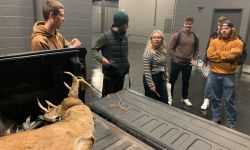For Michigan farmers, danger is another part of the job

LANSING – A tractor falls on you. A horse kicks you. A cow pins you against the side of a barn. Your hand gets caught in a corn shucker.
These are just some of the accidents Michigan State University researcher Laurel Morano documented in her recent study of agriculture-related injuries – and only among the most dramatic examples of the dangers farmers face every day on the job.
Agriculture has always been one of the most dangerous industries, both in Michigan and nationwide, Morano said. In 2021, agriculture, forestry, fishing and hunting accounted for 16% of the state’s workplace fatalities by industry, according to the U.S. Bureau of Labor Statistics.

But national statistics on farm injuries and deaths include only incidents reported by employers, Morano said.
“It’s been estimated that agricultural-related injuries are underreported by about 70%,” she said. “So we know we’re missing a lot.”
Related:
- Michigan dairy farm housing: ‘Invisible’ workers suffer, state looks other way
- Justice moves slowly in rural Michigan, thanks to prosecutor shortage
- Climate change is erasing Michigan winters, taking our heritage with them
In 2015, Morano and other members of MSU’s Division of Occupational and Environmental Medicine started working on a better method of tracking that data.
The researchers used hospital and emergency department records, poison control reports, workers’ compensation reports and news articles to identify 4,306 non-fatal farm injuries between 2015 and 2021.
Previously unrecognized trends emerged as a result.
For example, the researchers found that 37% of all documented injuries were caused by cattle, and older farmers were more likely than younger ones to have tractor-related accidents.
Revealing such data is the first step to making “the invisible visible,” Morano said.
“We do this to get a better idea of what injuries we’re seeing and to be able to hopefully provide injury information to prevent such events from happening,” Morano said.
The study appeared in the Journal of Agromedicine.
Nancy Nyquist, a policy specialist at the Michigan Farm Bureau, said that safety in agriculture is critical. The organization regularly holds local events to promote safety.
“Thankfully, improved safety education and technological advancements in agricultural equipment have led to a drastic decrease in on-farm injuries over time, but there’s no doubt that progress must continue,” Nyquist said. “Collecting data regarding farm safety is a key factor in helping steer future outreach and continues to play an important role in how farm safety is communicated.”
Bev Berens, who owns a farm in Vestaburg, Montcalm County, can attest to the dangers of farm life.
She’s been rammed by sheep. Her friend’s son was run down by a cow. Her husband was thrown off a tractor 30 years ago and still feels the effects.
“It’s always dangerous,” Berens said. “There’s just always a lot to be aware of.”
Berens manages communications and outreach at Michigan AgrAbility, a national program that provides services to agriculture workers with disabilities.
Older farmers in particular have slower reaction times and often suffer from arthritis, which can increase the potential for injury, Berens said. The average Michigan farmer is 57½, according to the National Institutes of Health.
Berens said she and her husband have their sons handle their cattle for that reason.
“I’m not quick enough,” Berens said. “My reaction time is slowed.”
She said that while farmers know the importance of safety, “sometimes we think we’re invincible.”
Danger is an accepted part of the job for many farmers, said Berens, who warns farmers not to let their guard down.
“If you have an underlying fear of it, then you need to do something else,” she said. “Just like if you’re an electrical lineman and you’re afraid of heights, you better do something else.”
“Most of the people that are involved in agriculture as an occupation — it’s not just a job they do, it’s their heart calling. They love it. They love the land, the livestock, the culture, everything about it. It’s who they are,” Berens said.
Capital News Service originally published this story.
Michigan Environment Watch
Michigan Environment Watch examines how public policy, industry, and other factors interact with the state’s trove of natural resources.
- See full coverage
- Subscribe
- Share tips and questions with Bridge environment reporter Kelly House
Michigan Environment Watch is made possible by generous financial support from:
Our generous Environment Watch underwriters encourage Bridge Michigan readers to also support civic journalism by becoming Bridge members. Please consider joining today.
See what new members are saying about why they donated to Bridge Michigan:
- “In order for this information to be accurate and unbiased it must be underwritten by its readers, not by special interests.” - Larry S.
- “Not many other media sources report on the topics Bridge does.” - Susan B.
- “Your journalism is outstanding and rare these days.” - Mark S.
If you want to ensure the future of nonpartisan, nonprofit Michigan journalism, please become a member today. You, too, will be asked why you donated and maybe we'll feature your quote next time!






